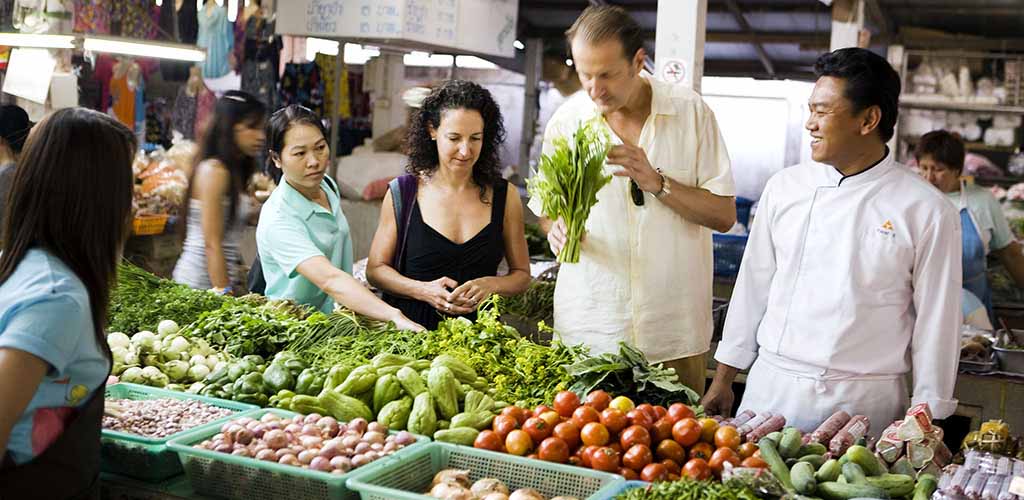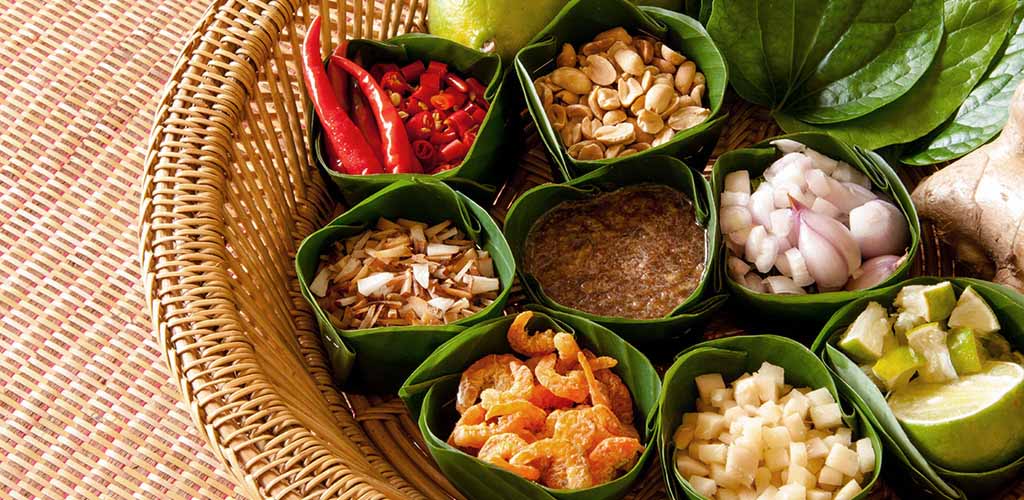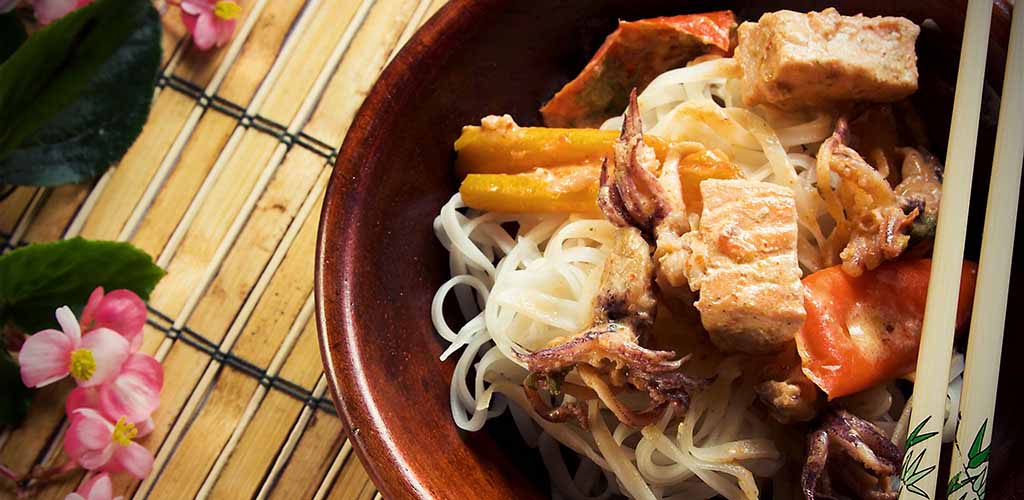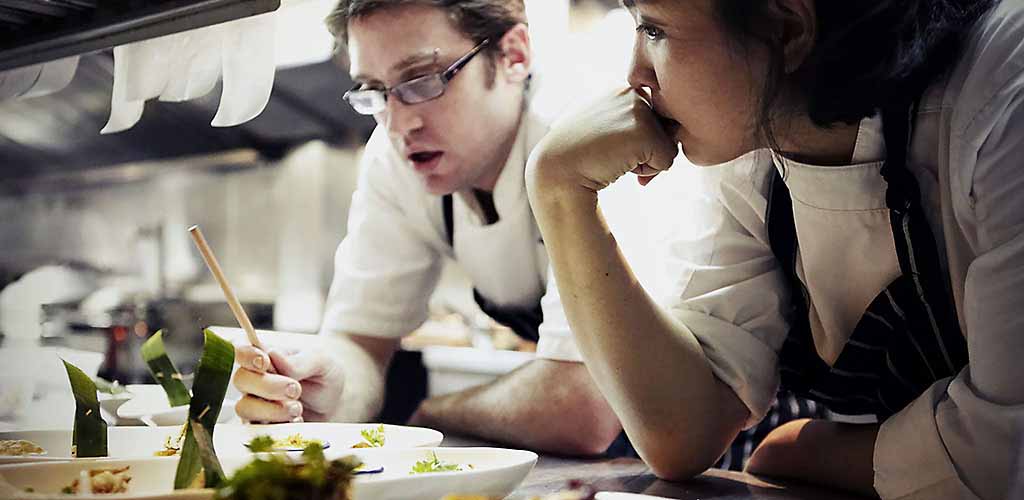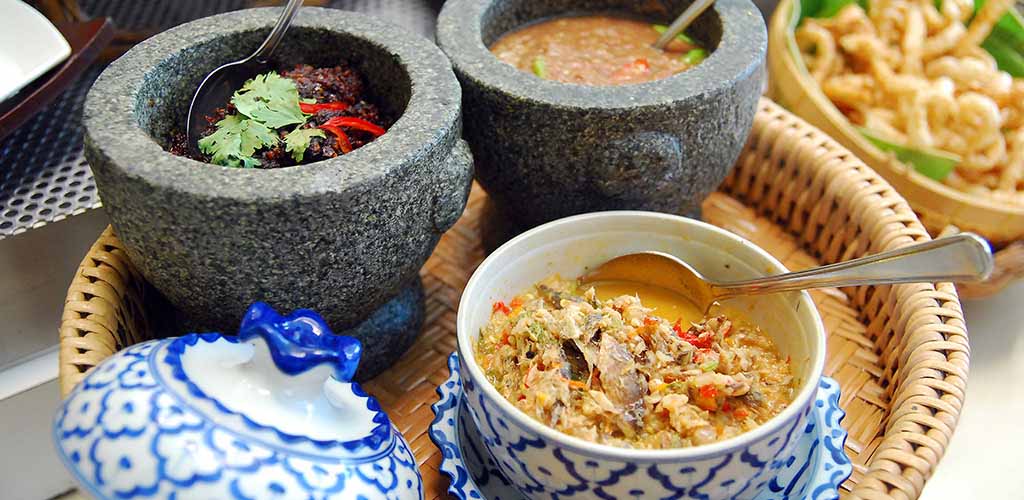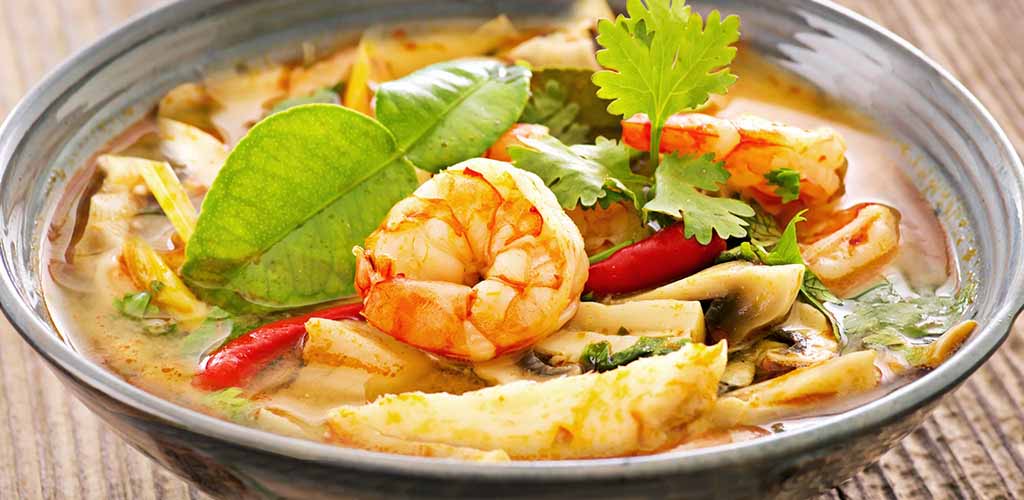Thai Cuisine
One of the world's favorite, yet most complex cuisines. The culinary experience in Thailand is overwhelming, an onslaught of exotic flavors and smells that tantalize both the nose and the palate. While food is an integral part of the experience everywhere in Asia, nowhere is this mantra more epitomized than Thailand. From first dish to last, marketplace to backstreet, to chic top-floor Bangkok restaurants, this is a cuisine that your senses will be remembering long after you left. We won’t simply teach you how to cook a green curry; instead, we’ve forged partnerships with Thailand’s best chefs, so they can provide all the rich detail that the gastronomy here demands. This includes a fine dining focus, but also invitations to small households for tasting ancestral recipes, floating out to vegetable markets and exploring all the unusual local delicacies.
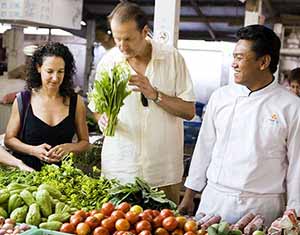 Benefit from our over 20 years experience while exploring the four culinary regions of Thailand, and master the four tastes, often all within a single dish. From Bangkok's culinary delights, Chiang Mai's amazing night markets, to Phuket's fiery dishes, our Thailand food tours are part of our focus on revealing the most authentic aspects of a country through food. Dine at the tourist restaurants or on the tourist streets sampling the best sweet green curry, pad Thai, and tom yum soup you've ever tasted. Our privately-guided tours explore cuisine in every one of your destinations. We have recommendations and arrange dining in each city, invitations to eat with the locals, chefs waiting to showcase their innovative creations, and guides that know exactly what to try at each street stall.
Benefit from our over 20 years experience while exploring the four culinary regions of Thailand, and master the four tastes, often all within a single dish. From Bangkok's culinary delights, Chiang Mai's amazing night markets, to Phuket's fiery dishes, our Thailand food tours are part of our focus on revealing the most authentic aspects of a country through food. Dine at the tourist restaurants or on the tourist streets sampling the best sweet green curry, pad Thai, and tom yum soup you've ever tasted. Our privately-guided tours explore cuisine in every one of your destinations. We have recommendations and arrange dining in each city, invitations to eat with the locals, chefs waiting to showcase their innovative creations, and guides that know exactly what to try at each street stall.

Traditional Thai Food
One of the world's most popular cuisines—everyone has a favorite Thai dish such Pad Thai or green curry chicken with a sweet Thai iced tea—Thai cuisine needs no introduction and certainly Thai food is one of the top highlights of a visit to the country.
Introduction
Thai food is known for its firepower, especially in the south, but traditional dishes don’t necessarily have to be hot nor spicy. There is a harmony of flavors not just in a Thai meal as a whole but also in each individual dish that combine the four Thai favorite tastes of sweet, sour, salty, and spicy (though not really a flavor per se). In a curry, for example, the sharpness of the chilies and the spices is toned down by the smooth sweetness of coconut milk, the saltiness of fish sauce, the aromatic flavor of the herbs and vegetables, and the mild heat of the red chilies. Another dish may feature a mixture of garlic, shallots, chilies, lime leaf, sugar and galangal (ginger). Rice is served at most meals; noodles, which are also popular, are not considered native to Thailand.
It's a little known fact that many Thai restaurants in the West are actually run by Laotians, whose cuisine is very similar. Western Thai restaurants typically make dishes much more milder than the spicy versions in Thailand. Keep this in mind when you explore the street stall cuisine in Bangkok and Chiang Mai. Without further ado, let's delve into the complexities of Thai cuisine.

The Traditional Thai Meal
Almost every household table to street vendor serves the Thai staple dishes here:
Khao (Cooked rice)
Sup (Soup) including favorites such as Tom Yum, chicken or vegetable noodle
Kaeng Ped (Curry) such as the tom kha gai pictured below (green curry chicken), and tom ka gai (Thai Chicken Soup)
Khrueang Kaeng (Condiments or side dishes)
Khong Nueng or Khong Thot or Phat or Khong Yang (Steamed, Deep fried, Stir Fried, or Grilled dishes)
Khrueang Chim (cooked vegetables) and condiments or Yam
(A strongly flavored dip with vegetables and fish or salad)
Khawng Waan ("sweet things" or dessert – typically one liquid and one dry)
Phonlamai (Fruit) – som tam phonlamai, for example, is Thai Fruit Salad
Popular Dishes in Thai Cuisine |
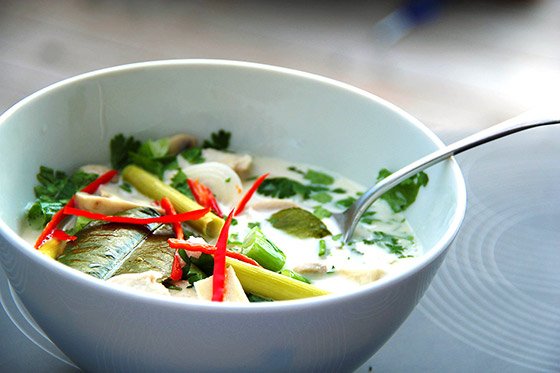
Now that may seem like a lot of food and these days, people rarely sit down for a full menu, especially not three times a day. Breakfast is usually khao tom or boiled rice with chicken or pork served with an egg dish or salted fish and pickles. Lunch normally is light one dish meal of noodles, fried rice or rice and curry and a typical dinner will comprise two or three dishes with rice. Dishes are not served by courses, but all at the same time. One should take a mouthful of each dish in whichever order one prefers, dining "family style."

Ingredients in Thai Cuisine
Common Ingredients in Thai Cuisine |
A staggering diversity of ingredients divulges a plethora of flavors, aromas, textures and colors that culminate in an eclectic cuisine that is sought after throughout the gastronomic world. With such a wondrous culinary repertoire to please every palette, it’s no wonder that Thailand is known as the ’Land of Smiles.’
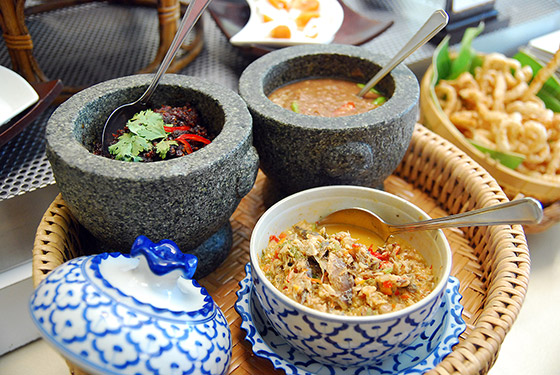
In every Thai kitchen, as it is in Vietnam, fish sauce predominates. Indeed, most fish sauce in North America and elsewhere is imported from Thailand. Fish sauce in Thailand is known as nam pla, a pungent brine made from fermenting fish with salt and containing only anchovies, salt, and water. It is extremely salty with over one thousand milligrams of sodium per tablespoon, and used as salt is in the West. A common table sauce is made from mixing minced fresh green and Serrano chilies and garlic with fish sauce. Use this recipe for Fish Sauce with Chiles as a condiment or in place of regular fish sauce in recipes.
Curry paste is also ubiquitous and cooks stock up on pre-packaged curry pastes made from lemongrass, galangal, and coriander root. In addition, green curry paste is flavored with green chilies and red curry paste with dried red chilies... yow! These pastes can be found at most supermarkets.
Limes and unseasoned rice vinegar add the Thai favorite taste of sourness to cooking and dipping sauces, including nam jim, a sauce that is served with grilled chicken.
Everyone knows Thai cuisine makes liberal use of coconut milk. The staple of Thai curries, coconut milk is created by flushing the oils out of coconut flesh with heated water. Of course, we have canned coconut milk in the Asian section of the supermarket to save this process. Coconut milk is very fatty and this can be reduced by diluting with water.
Both fresh and dried chili peppers add the heat in Thai dishes. Raw cayenne chilies are used in curries and blazing hot Thai ’bird’ chilies are used in sauces and stir-fries. Dried red chilies are a staple in curry paste and add zing to soups and stir-fries.
Fresh lime juice provides a sour note to grilled meats, salads, and Thai fried rice. The Lime leaves are often used in Thai cooking as well, providing a mild citrus taste to curries and soups.
Garlic and shallots are popular in Thai cooking and dipping sauces, with raw, sliced shallots tossed into salads and garlic used much like it is in Western cooking, crushed and saut’ed in hot oil.
Thai herbs (below) include impressive amounts if cilantro, mint, three varieties of basil and coriander (also popular with Vietnamese cuisine) to add flavor to everything from raw salads to curries and fried rice.

Thai vegetables
The richness of Thailand’s soil unearths a gourmet’s paradise of vegetables, almost all of which are herbal. Vegetables are a proud concern for Thai people who hold good nutrition and health in high regard. Moreover the range of vegetables they are blessed with are characterized by mild to strong aromas, giving way to a kaleidoscope of taste sensations.
Popular Thai Vegetables |
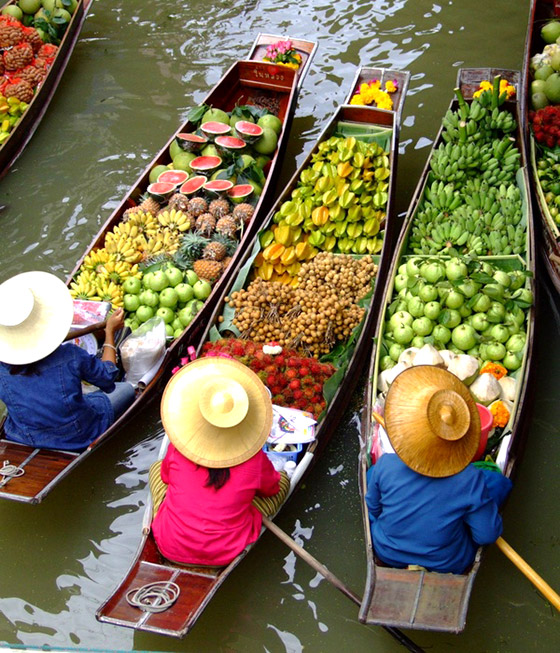
Popular vegetables used in Thai cooking include angled loofah (buap liam), apple aubergines (makheua), and other listed on the right.
Loofah is used in stir-fries and soups, and is often boiled and eaten with nam phrik. Small round aubergines are pale green, yellow or white and are eaten raw with the ubiquitous chili sauce, nam phrik, or cooked in curries. Corn is a popular vegetable in Thailand for stir-fries and soups, but Thais prefer baby corn cobs, which have a musty sweet flavor, as well as a crunchy texture. Bamboo shoots are crisp, mild-flavored, white to ivory shoots of the bamboo plant, a popular ingredient in Thai dishes. Banana blossoms are a popular salad ingredient, tasting somewhat like artichokes.
Bell Chili, or phrik youkg, is light green in color and mild in taste. They are used in spicy salads and chili Pilstes for their fragrance, and in stir-fried meat dishes for both flavor and aroma. Bean sprouts (thua ngok) are liked for their delicate, pleasant and unique crunchy texture. Bitter melon (ma ra) is a tropical, annual vine which has a bitter taste used in soup, curry, and salad. Kale (phak ka na) is delicious stir-fried, steamed, or boiled (but never eaten raw). The most popular dish in Thai cooking with kale is ka na nam mun hoy, is stir-fried dish with oyster sauce.
Chinese chives (kui chai) are pungent herbs that look more like long, flat spring onions than their Western equivalent. The leaves are peppery, crunchy and chewy and are eaten raw and cooked, liked for both their texture and flavor. Spring onions can be used as a substitute but they will not have the distinctive garlic taste of Chinese chives.
Chinese long beans (tua fugk yaew) also known as known as the yard-long bean, bora, long-podded cowpea, asparagus bean, pea bean, or snake bean. In China, you'd see this bean quickly stir-fried Sichuan style with red chilies, Sichuan peppercorns, and sesame oil. The Thais make it similarly but also add it to other dishes, such as green papaya salad. Getting hungry yet? Watch Anthony Bourdain eating drunken noodles in Bangkok on his show Parts Unknown (below).
Chinese Radish (hua chai tau or hua phak kat) Thais value this vegetable, believing that it aids digestion, cools the body and improves blood circulation. When raw, the flavor of mooli is cool, sharp and peppery, and the texture is crisp. Thais don’t often eat it this way, but the grated flesh is sometimes used to tenderize seafood. When the vegetable is cooked, the characteristic texture is retained, but the flavor becomes quite sweet.
Long Eggplant (makhua yaew). This elongated variety is similar in appearance and flavor to Japanese long baby aubergines. However, the Thai ones are usually pale green, but can also be purple or white and are usually served grilled (broiled) or in green curries.
Lotus root (raug bua) is an underwater root that grows to be as long as four feet. The root is dark reddish brown and needs to be peeled prior to using. The flesh is a creamy white and tastes similar to coconut. Lotus root is available canned, dried or candied and can be used as a vegetable or in dessert dishes.
Pak Choi (phak kwang tung Taiwan) The most popular variety of cabbage eaten in Thailand, often eaten raw with a chili dipping sauce and is also cooked in stir-fries and soups.
Pea Aubergines (makreu puang) are pea-size berries, which grow in small clusters, have a bitter flavor that is a good foil to the richness of the spicy curries in which they are most often found. They are also used as a flavoring for nam phrik.

Pumpkins (fug tong) are a variety known as the sugar pumpkin that has sweet flesh. In Thai cooking, it is commonly used in dessert but is also used in savory dishes.
Straw mushroom (hed fang) are delicate, sweet flavored mushrooms have acquired their English name because of the method of cultivation on beds of straw. They look like miniature helmets and are the most popular variety of mushroom in Thai cooking used extensively in soups, salads and curries, and taste particularly good with prawns (shrimp) and crab meat.
Taro (puak), a root grows wild on the banks of streams in Thailand and is particularly popular in the north of the country. The swollen tuber is full of starch and is eaten in the same manner as potatoes. The young leaves can also be eaten. Popular in the Philippines as well.

Thai fruits
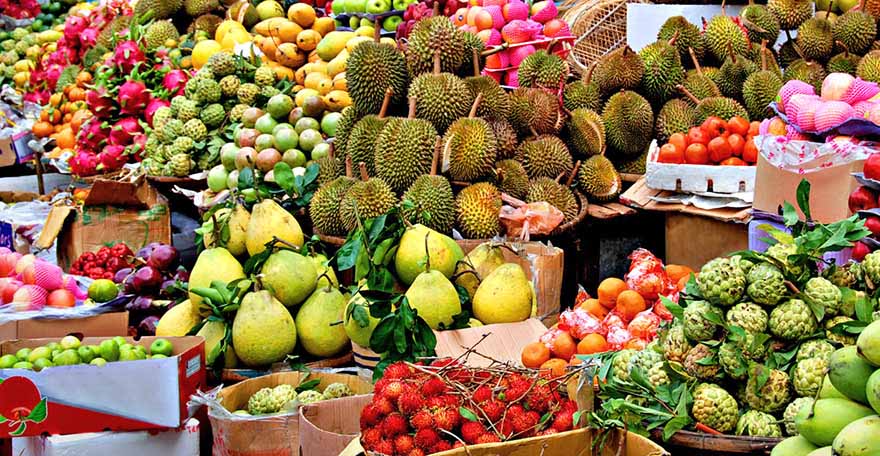
Perhaps the most unique aspect of traveling to tropical Asia is the exotic fruits travelers have never encountered before. The tropical climate and natural fertility of Thailand combine to produce the world's most outstanding and unique variety tropical fruits. The sight of colorful market stalls featuring every conceivable shape and size are joined by road-side stands of impressive towering displays, while in addition to astounding sweetness, even Thailand’s fruit harvests include pungent and sour varieties.
Popular Thai Fruits |
Thais love their fruit and eat it with nearly every meal. As you explore the country, you'll quickly notice it's available on the street almost everywhere with a broad variety (there are over 20 different varieties of banana alone).
Much of the fruit in Thailand is familiar to travelers already, such as lychee and longan, which are now produced in Florida, with mangoes imported from Mexico, Central America and South America. In addition, some fruit is imported from Thailand (in frozen form) such as durian, longan, lychee, rambutan, and mangosteen.
One of Thailand's most famous and well-liked dishes is made with fruit, green papaya salad.
Mangoes (ma-muang) are one of the favorite fruits in Thailand and most well known with good reason, as Thai mangoes are among the world' s sweetest. Varieties include ataulfo (also called champagne), is also available in the spring (and mostly imported from Mexico to the U.S.A).
Longan (lum yai) is a favorite Thai fruit. The flesh is translucent (with the black seed is visible). Slightly smaller than a lychee with a smooth, dull brown skin, Longan has a unique taste that's somewhat similar to grapes, but more exotic —similar to that of a lychee but a little sweeter and not as juicy.
Ripe Papaya (malagaw sook) is eaten both when the fruit is ripe and when it's still green in Thailand. Ripe papayas are a favorite fruit and the flavor is somewhat similar to ripe persimmons.
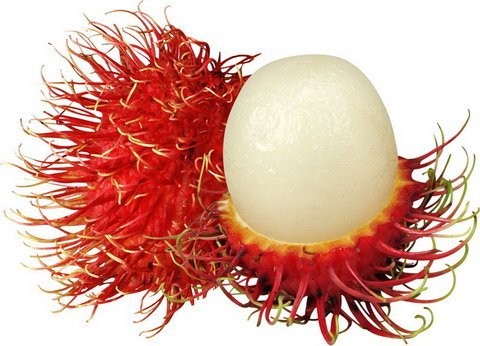
Rambutan (ng-ock) is a favorite fruit of Thais, is a bright red fruit with "hairs" on the outside (to the right) with flavor similar to lychee fruit with a seed in the middle. The taste is similar, though less sweet and drier than a grape.
Guava (farahng) resembles an apple and has tiny seeds inside. Tasting is more like a crunchy pear than an apple, guava is used primarily to make juice.
Papayas can vary a great deal in shape and size, but you will astound to the massive size of Thai papayas. The popular varieties are cylindrical and grow up to 35 cms. long (over a foot or more). The skin is reddish-orange and when ripe, the flesh is red, firm and sweet.
Jujube (phut saa), or Chinese Date, is picked unripe from a thorny tree and eaten with dipping sauce. The Jujube is small, round, and oval shaped and is only three to four cm in size has 15 varieties. The main variety of this sweet fruit has a tasty white flesh and is very popular as a juice. When eaten fresh, it is typically spiced with sugar and chili dip.
Thai bananas (kluay num wah) resemble plantains, but the flavor is much sweeter. They should be eaten when the skin is yellow.
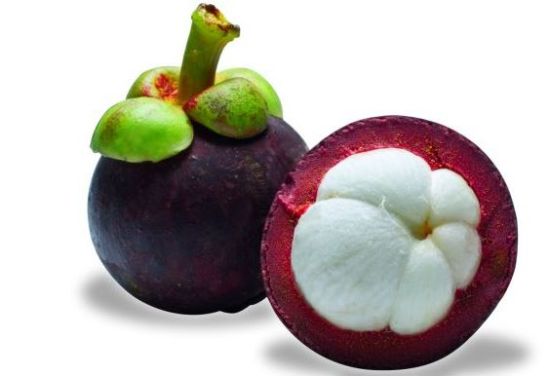
Mangosteen (mongkut) - to the right - is a reddish-purple colored fruit that appears to be wearing a festive hat! The flavor is a sweet and sour cross between an apple and a pear. Known as the "Queen of Fruits", mngosteen is actually a berry, with about the size of a mandarin although with a tougher, leathery reddish-purple rind and a stark white, fleshy center. It is very sweet and mildly acidic. Usually picked and sold in the market wheile green, it is ready to eat when it reaches a yellow-orange color.
Noy Naong is similar in flavor to a very sweet, juicy pear. The ripe fruit can be scooped out with a spoon and eaten like pudding.
Lychees are about the size of a golf ball and within the brittle shell of these pinkish-red orbs, is a translucent white pulp with a delightful sweet flavor. While most have a large shiny brown seed the most desirable variety, known as "chicken tongue," contain a smaller atrophied seed with more pulp than other varities.
Golden Apple (makok num), tastes somewhat like a crabapple and is eaten before it ripens, usually with dipping sauce.

Dragon fruit (pitaya) is fruit of a cactus plant and the flesh looks like that of a kiwi which is typically scooped-out with a spoon (right).
Sweet Tamarind (makaam waan) has a taste similar to prunes or dates and is eaten as a snack. Tamarind is used as a flavoring in sour soups such as Tom Yum.
Persimmon (luke pawp) resembles a tomato in shape and tastes like a medium-sweet papaya (not quite ripe). Persimmons are usually eaten when firm and are crunchy in texture.
Coconuts (ma prow gae) are available in some Asian markets. The coconut must be cracked open and the meat is removed (that's what coconut milk and cream is made from)

Thai herbs
Thai Herbs
|
Fresh, dried and ground, Thai chefs infuse herbs to establish a Yin and Yang harmony of opposing forces, with dishes evaluated in terms of their delicious results as well as their medicinal effects. "Cold" or Yin foods soothe and cleanse the body compared to "hot" sensuous Yang foods which increase the pulse rate and trigger perspiration, unfolding a firm belief that an equilibrium of these elements will promote a long and healthy life.
To the right are several herbs and spices essential to Thai cooking. Combining these herbs is regarded as a fine art in Thailand and time consuming (the preparation of a sauce can require several hours of grinding herbs, taste testing, and adjusting until the optimal balance of flavors is reached.
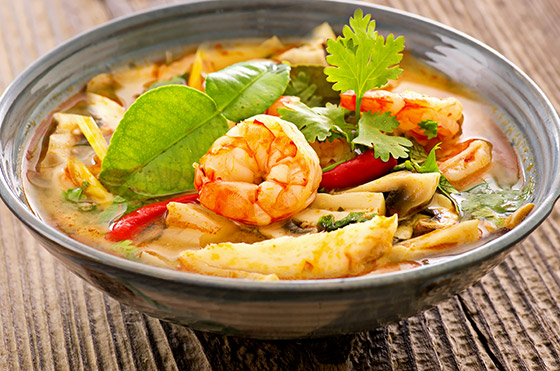

Thai Spices
Common Thai Spices
|
Living up to their reputation, Thai spices certainly do factor in creating one of the hottest of global cuisines. For a real life example, watch Anthony Bourdain's episode below, visiting a street stall to sample some fiery Thai dishes.
Which region you visit will define the level of spiciness you encounter, with the north-east region of Thailand only being trumped by the scorching creations found down south. But even in these distinctly spicy culinary pockets, each and every recipe promises well selected and carefully proportioned ingredients that dish up an appetizing balance.
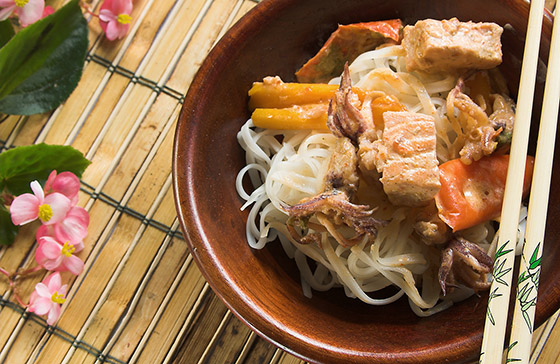
Basil is one of Thai cuisines most common ingredients, with three different varieties used. With an anise-like flavor, Thai basil is used in most Thai curries and stir-fries and also eaten raw with noodle soup. Holy Basil (Bai Grapow) is a peppery basil also used in stir-fries. Holy Basil is commonly eaten raw Lemon Basil, or bai baeng-luck, is added to soups and to flavor steamed fish and vegetables. Likeits name, lemon basil has a rich citrus-like aroma and flavor.
Raw Thai chili (prik kee noo) is a main spice in Thai dishes and the main culprit for its fiery effect. Often eaten raw.

Standout Thai Restaurants and Dishes not to miss
Issaya Siamese Club (Bangkok)
Renowned chef Ian Kittachai of the must-visit Issaya Siamese Club, which single-handidly set the direction for Bangkok's modern food scene, offers up this savory traditional gem, Keaw Warn “Like a Soup” Goong, homemade green curry paste soup with prawn, basil, kaffir lime leaves and heart of palm.
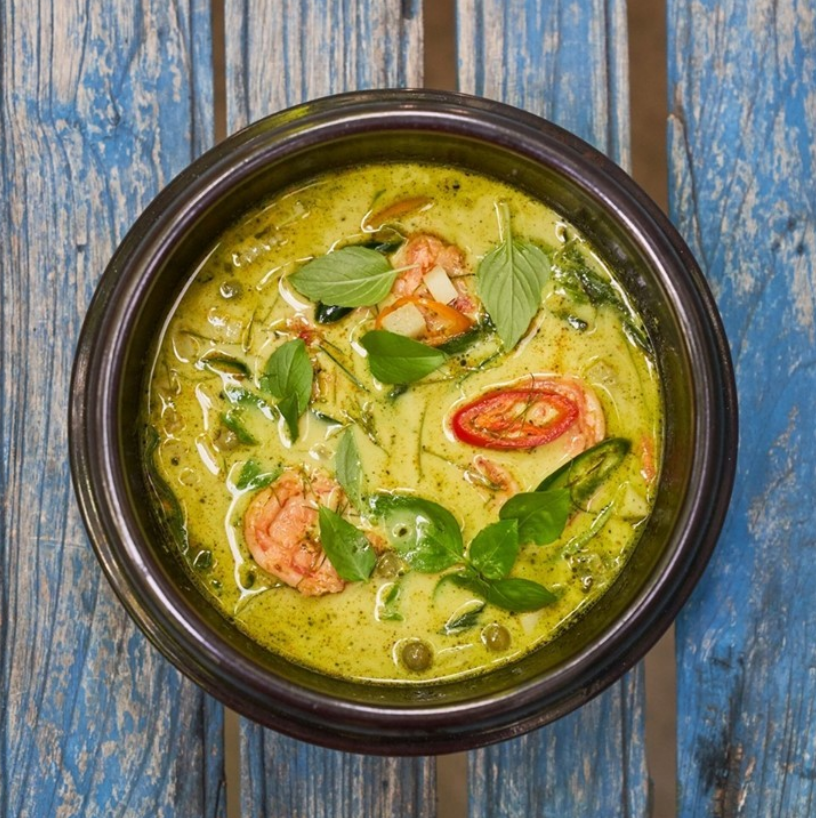
Bo.Lan (Bangkok) - CLOSED
Bangkok culinary trendsetters Duangporn "Bo" Songvisava and husband Dylan Jones, offer this unique take on Thai sweet and spicy, with a lycee curry: "Fruits like rambutan & lychee were commonly used not only for dessert but also in savoury dishes like salad, curry and soup. Once sugar were considered as luxurious and pricey product. Natural sweet from fruit then were used in food as sugar substitution."
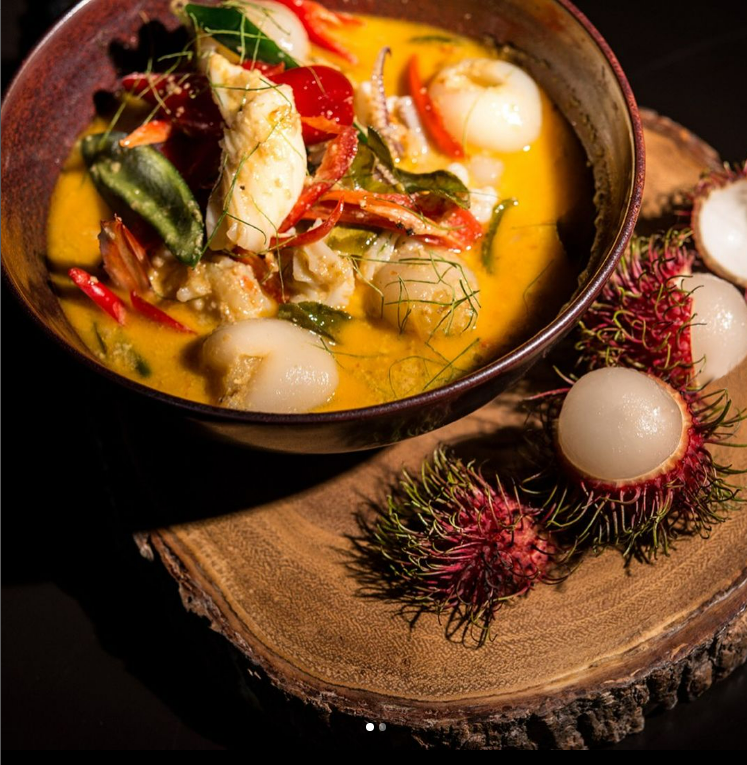
See our full Bangkok dining guide

Thai Regional Culinary Styles
Blue Elephant Class MenuAncient Thai Cuisine CourseStartersSoupMain CourseDessert |
Thailand, like Italy and many other countries, is a country of many regional cuisines with Bangkok a nexus of all provincial styles and is a wonderful place to sample the country's finest styles. There’s everything from world-class restaurants, to scrumptious street side stalls. As in other regional cities, don’t neglect your hotel, some restaurants like the Biscotti and Shintaro (Four Seasons), Basil (Sheraton Sukhumvit), The China House and Le Normandie (Oriental), New York Steakhouse (JW Marriott) and Mei Jiang (Peninsula) are excellent choices. In the "Lanna Kingdom" in and around Chiang Mai, harness your courage to sample some of the hottest dishes in the country the region is famous for.

Thai Cooking Class, Schools, and Other Culinary Activities
Thai cooking schools abound, including the popular and casual, Blue Elephant Cooking School in Bangkok (menu example to the right). Contact us for other local places to study Thai cuisine, formally and informally, including private cooking activities. Cooking classes typically include a market tour, learning and gathering ingredients. We can also arrange private cooking classes with top chefs, including Ian Kittachai of the renowned Issaya Siamese Club, by availability. Chiang Mai and Bangkok are the prime places to take a cooking class, but on the islands and far north should also be considered to discover the regional specialities.
Laos cuisine has influences on Thai food, especially on Issan cuisine in the Thai province across the Mekong from Laos. If you're traveling to Laos with us, we can also arrange culinary activities there.

Thai Street Food
Thailand is famous for the most delicious street eats in the world. It's hard to walk any main street in cities without sampling the savory dishes being prepared right in front of you along the way in pop-up tables or carts, with chairs prompting one to stop and watch the cooking action. The country’s night markets are especially interesting for stall food, including the legendary Chiang Mai Night Bazaar which is not to be missed for any foodie. Malls feature food courts, often on the top floor with views and some , such as the ICONSIAM have multiple food courts offering delicious meals.

More about Thai Cuisine Online
Learn about Thai dish ingredients and more at Taste Atlas.
A favorite recipe for Green Papaya Salad at Bon Appetit.
Amazon Prime offers the full episode of Anthony Bourdain's No Reservations episode in Thailand. Also The Parts Unknown episode set in Thailand (2014).
Our Other Food Trips
Vietnam Food Tours
If you have interest in that other great regional cuisine, Vietnamese, don't miss out on the best culinary tour of Vietnam: Culinary adventure from Hanoi to Saigon.
